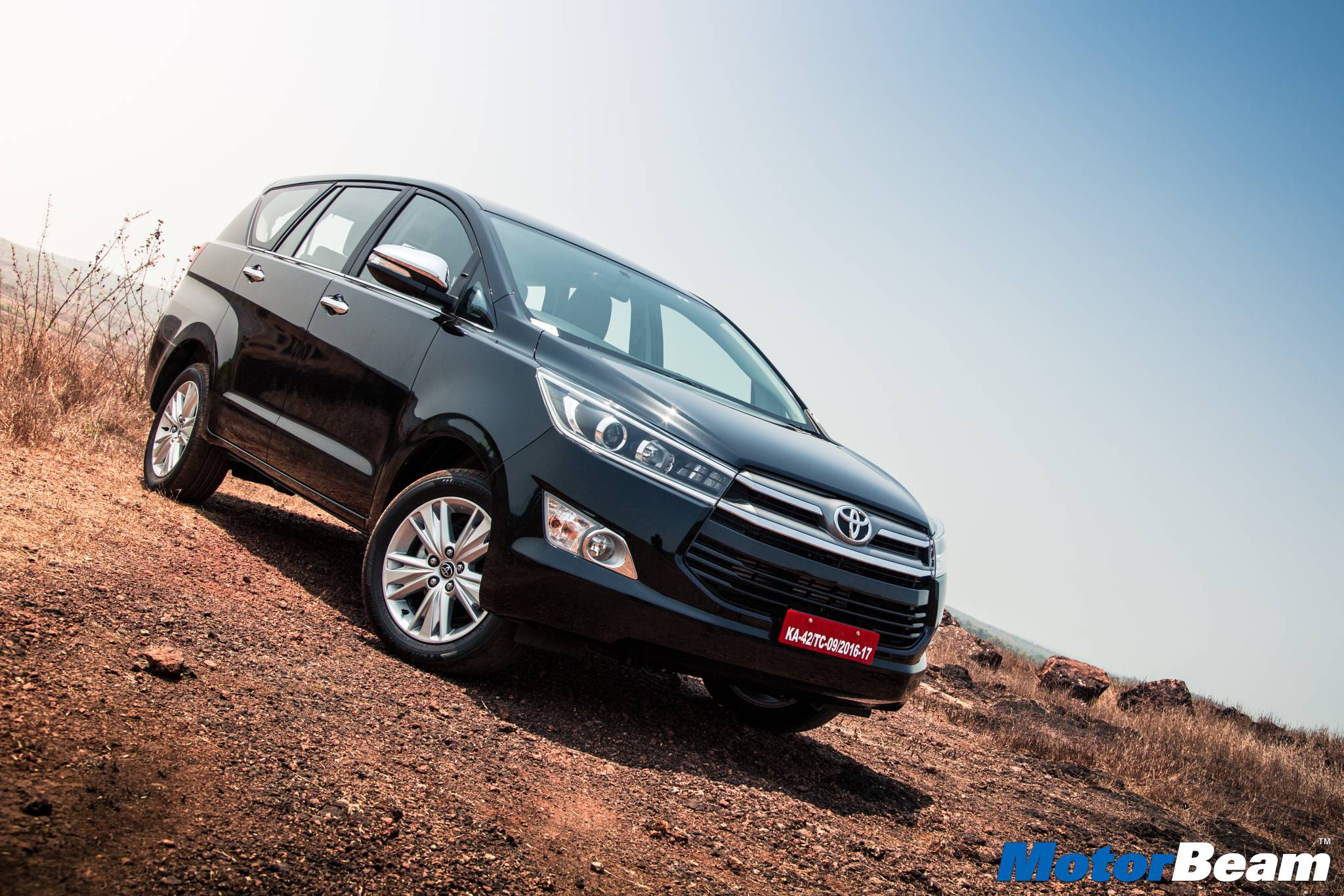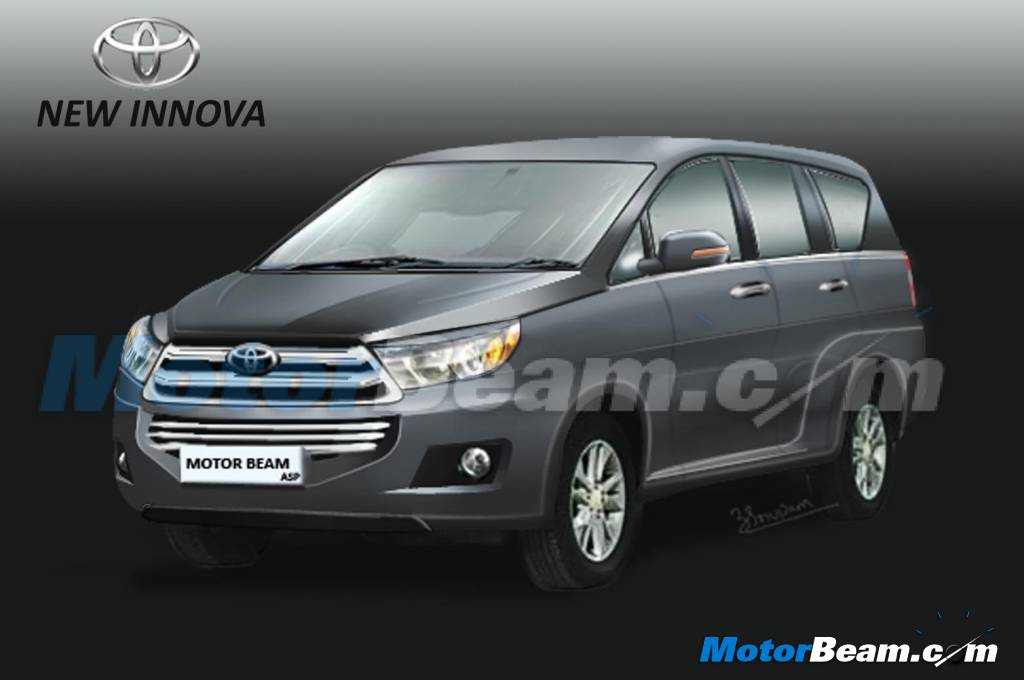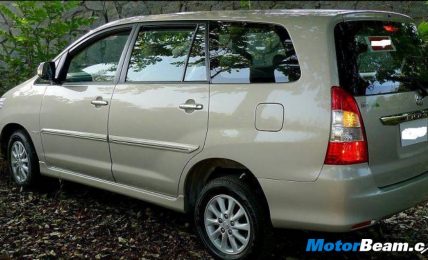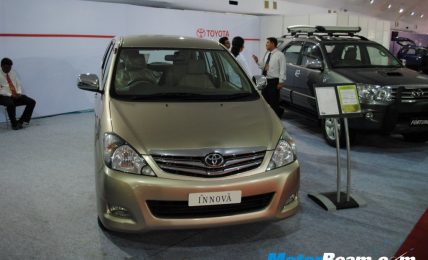
2016 Toyota Innova Crysta Review
Car Tested: 2016 Toyota Innova Crysta; Road Test No. 691
Price OTR Mumbai: Rs. 17.13 – 24.41 lakhs
The Toyota Innova Crysta has taken a full generation leap ahead and it is very evident
Toyota can be credited for kick starting the MPV revolution in India as the Qualis, which was the company’s entry model for our country, worked very well. The Japanese automaker replaced the workhorse Qualis with the Innova which was positioned towards the private car buyer but in spite of that, the Innova still wooed the commercial segment which still swears by this car. The success of the Innova, which became Toyota’s top seller in India, also sent wrong signals to other automakers who started to think that the MPV market is booming. The MPV segment is itself the Toyota Innova and now the automaker has unleashed the second generation model which gets the Crysta name to it. How big is the leap between the two generations of the people mover?
Motor Quest: Toyota launched the first generation Innova in 2004, which was the spiritual success of the Kijang that was launched in 1977 (four generations were sold, the last of them was the Kijang Qualis). The Innova was first launched in India in 2005 and got a slew of updates over the years. The second generation Innova was unveiled in 2015 and was showcased locally at the 2016 Auto Expo.
The Innova retains the same wheelbase as before but is longer
Exteriors – In terms of aesthetics, the Toyota Innova had a well balanced design for an MPV. Buyers always appreciated the simple styling with a touch of premium feel on the range topping variants with a dose of chrome. However, the latest cosmetic update of the Innova looked quite garish with the overdose of chrome on the huge grille up front and the afterthought panels at the rear section. Now the new generation Innova has come with drastic changes that not only makes the styling fresh but the silhouette also gets a bit SUV-ish with an upright stance. It gets a sleek new projector headlight cluster upfront merging with the two-slat chrome grille. The bumper gets muscular creases and now the bonnet is flatter instead of the steeply raked down one seen on the outgoing model.
The Toyota Innova does look more premium now from all angles
The Innova’s styling has evolved to exhibit a more polished appearance
The new side profile comes with smart lines and panels that cut the bulk and make it look more cheerful than before. There is a sharp waistline emerging from the headlight and connecting the tail-light. The 17-inch alloys look upmarket, the chrome strip running on the side amplifies the premium factor while the kink on the D-pillar adds some drama. The rear however looks a bit weird at first glance, which might grow on you over time. The boomerang shaped tail lights are a bit loud, otherwise the tail gate is designed well and doesn’t look bulky like the previous Innova. Overall, the design is a big step up that will make its presence felt on Indian roads.
The interior has taken a big step ahead with better aesthetics
Interiors – The interiors of the new generation Toyota Innova is a massive leap ahead. The design is very elegant and more luxurious than before. Toyota has managed to fit in an entire piece of mould on the dashboard instead of assembling separate panels, which was a very challenging task for the engineers. It has a wave sort of pattern that emerges from the passenger side and enhances towards the driver’s console. Having said that, there is a 3D instrument cluster behind the steering wheel that looks fresh and gets a big informative MID screen. The steering wheel feels excellent to hold specially with the gloss wooden insert on top. It has all the controls for the infotainment system on either side and offers tilt and telescopic adjustment.
The second row is the best place to be in, offers super comfort
The Innova now gets a large touch-screen infotainment system which is integrated very well in the dashboard. It is quite user friendly and offers navigation system but unfortunately Toyota has missed out on Apple CarPlay, which is being offered on newer lot of cars (cheaper ones too) nowadays for better connectivity. The lower half of the centre console now houses a new automatic climate control that is quick in cooling the cabin. The quality and finish of the new Innova is excellent, it doesn’t feel like a Japanese car and instead has more of an European feel to it. All the switches and panels used feel robust and long lasting, which is a boon for buyers planning to use it for lakhs and lakhs of kilometres.
The last row isn’t really for adults but has three proper seatbelts
There are lots of storage bins inside, around 20 bottle holders! Every door can accommodate three 1-litre bottles each. There are two gloveboxes, the upper one is a cooled glovebox which can store two bottles. Also there are flip open cupholders for the front passenger and driver in front of the AC vents so you can keep your drinks chilled. Between the second row of seats there are two bottle holders that flip open, then there are these two trays that can hold a 500 ml bottle each. The last row also has cupholders and the ones on the right are chilled cupholders that can accommodate three of them. There is a good sense of space inside the cabin and at night the ambient lighting looks cool.
The flexible seating and luggage options make the Innova practical
The Innova has a cabin which is high on practicality with 20 bottle holders and supremely comfortable seats
The seats of the new Innova are very comfortable and wide. The seating is highly flexible and offers ample space for all the passengers. Second row seats have great legroom, headroom and shoulder room, which is much better than the outgoing model. There is a control for the chauffeur driven owners to adjust the front passenger seat from behind. There are a lot of convenience features like the second row also has auto climate control, the windows are one touch up/down, push button start, power foldable ORVMs, electric driver seat adjustment. The last row seats are good enough for kids but adults would only manage to sit for short stints because of the limited headroom. However, all three seatbelts at the back are proper ones and not lap seatbelts, which is a good aspect for safety. Even with the third row up you get a very practical and spacious boot while the third row has a 60:40 split and is highly flexible to accommodate cargo and passengers together easily for long routes. All-in-all, Toyota has nailed it this time with the interiors of the Innova getting a mix of Corolla quality and Camry design.
All new GD diesel engines are much more refined and powerful
Performance – Toyota has replaced the KD series of diesel engines with the GD series. The new oil burners are vastly improved in every regard, featuring richer hardware and crucially a big jump in power and torque outputs. Both the 2.4-litre and 2.8-litre engines are similar in hardware and also get Eco and Power modes – which naturally alter performance (the default mode is in between both). So in Eco mode, you can feel the motors don’t rev so quickly while in Power mode, the added punch is very apparent, the Innova being very quick to pick up speed.
The Innova gets 3 driving modes – Eco, Normal (default), Power
The refinement and performance of the new diesel engines really stand out
The 2.4-litre oil burner comes matched to a 5-speed manual gearbox which offers smooth shifts, the clutch too is light. But the gear lever vibrates a lot on start-up, just like in the first gen model. The 2.8-litre diesel is only offered with a 6-speed automatic gearbox and while shifts aren’t the quickest, they are smooth. One can also shift gears manually by using the tiptronic function on the gear lever. Both the engines have a bit of lag lower down which is quite well masked and power delivery is very linear, the mid-range being the strong suit of the GD mills.
The 2.8-litre automatic makes the Innova very easy to drive
In the 2.4-litre manual, 100 km/hr in top gear results in 2200 RPM on the tachometer while the ton comes up in third gear. The new Innova does feel more relaxed while cruising unlike the old model where you would miss a sixth gear. Both the engines redline at 4500 RPM and the big improvement in the Innova is the refinement, there are very little vibrations inside the cabin. However, push the motor hard and the engine makes quite the sound, still better than the old Innova but could have been better. Fuel efficiency isn’t great with ARAI claimed mileage being 15.10 km/l for the 2.4-litre model while the 2.8-litre automatic manages 14.29 km/l, a mild hybrid system would have done the trick. The increase in weight by a considerable 200 kgs is reason to blame for the average fuel economy.
The steering is heavy at low speeds but should have weighed up better
Driving Dynamics – The Toyota Innova has grown in size and gets a new frame but is also heavier now. In the early days of the Innova, people worried about the dimensions of the car as it was called too big for the city. The new one is even bigger and thus less maneuverable. Still underpinned by a body-on-frame platform with the steering still being a hydraulic unit, the Innova feels heavier to drive than before as the steering is on the heavier side and requires effort at low speeds, taking u-turns can be taxing. It does weigh up decently at high speeds but there is still a lot of slack in the straight-ahead position.
Ride quality is simply excellent even on the worst of roads
The Toyota Innova has an excellent ride quality which ensures utmost comfort
There is very good stability as you cross triple digit speeds, the Toyota Innova Crysta holding its line well on our not so perfect roads. The car also gets what Toyota likes to call ‘aero stabilising fins’. Without doubt, the biggest improvement has come to the ride quality of the vehicle. The work on the suspension is immediately apparent as this MPV rides beautifully even on bad roads. Bumps are absorbed very well and that’s inspite of the firmness at low speeds. Vertical movements are very well controlled and as you up the speed, the flatter ride only becomes better. There is quite a lot of body roll though but the Innova handles quite well for its weight and size. The brakes have good stopping power.
Toyota has made the Innova very safe with Euro NCAP 5 stars in mind
Safety and After Sales Service – Toyota has upped the game in the safety department as well. The Japanese automaker is providing seven airbags with the new Innova including a driver-side knee airbag for the range topping ZX variant. Dual front airbags and ABS is standard across all the variants. There is Vehicle Stability Control and Hill-Start Assist Control on offer as well. Toyota is providing 3-point seatbelts with adjustable headrests for all the passengers including third row seats. The Toyota badge is known to offer hassle-free after sales in India with a wide reach and network spread across the country. Longevity is tried and tested while the resale value of Toyota cars is up there as well. We expect low maintenance and spare parts cost due to high localisation (the diesel engines will soon be made in India).
The Toyota Innova Crysta is easily the best MPV in the Indian market
Verdict – The Toyota Innova has mostly been seen as a people mover but was ageing and it showed. The new model excels on several fronts, it certainly looks more pleasing to the eyes, the interior is vastly improved in both aesthetics and comfort, the feature list has soared with a ton of equipment, including safety tech and the engines now pack in quite the punch. With a splendid ride quality on offer and Toyota’s known reliability and quality, the new Innova Crysta might be expensive but makes for the perfect vehicle under Rs. 30 lakhs for the family.
Although the Innova becomes more expensive, it has no real competition
What’s Cool
* Appealing design, the Innova no longer looks boring
* Interior design, space and features are excellent
* Practical cabin with a ton of storage spaces
* Punchier performance with more power than the 3.0-litre Fortuner
* Fantastic ride quality ensures comfort at all times
* Toyota’s bullet-proof reliability and resale value
What’s Not So Cool
* Heavy steering at low speeds and big size make it city un-friendly
* Engine noise should have been better insulated
* Loaded with features but misses out on Apple CarPlay
Alternatives: None
The Toyota Innova Crysta is the perfect vehicle for large families
2016 Toyota Innova Crysta Specifications
* Engine: 2393cc, 2GD-FTV, 16V, 4-cylinder, Turbocharged, DOHC | 2755cc, 1GD-FTV, 16V, 4-cylinder, Turbocharged, DOHC
* Power: 150 PS @ 3400 RPM | 174 PS @ 3400 RPM
* Torque: 343 Nm @ 1400-2800 RPM | 360 Nm @ 1200-3400 RPM
* Transmission: 5-speed manual | 6-speed automatic
* 0-100 km/hr: 13 seconds (est.)
* Fuel Consumption: 11 km/l | 9 km/l
* Fuel Type: Diesel
* Suspension: Independent double wishbone (Front), Multi-Link (Rear)
* Tyres: 215/55/17
* Brakes: Ventilated Discs (Front), Disc (Rear), ABS
* Safety: 7 Airbags, ABS, EBD, Vehicle Stability Control and Hill-Start Assist Control
2016 Toyota Innova Crysta Dimensions
* Overall length x width x height: 4735 mm X 1830 mm X 1795 mm
* Wheelbase: 2750 mm
* Ground clearance: 167 mm
* Turning radius: 5.4-metres
* Fuel Tank Capacity: 55-litres
* Kerb Weight: 1855 kgs | 1870 kgs
Further Reading –
2016 Toyota Innova Crysta Video Review
2016 Toyota Innova Crysta Petrol Review




